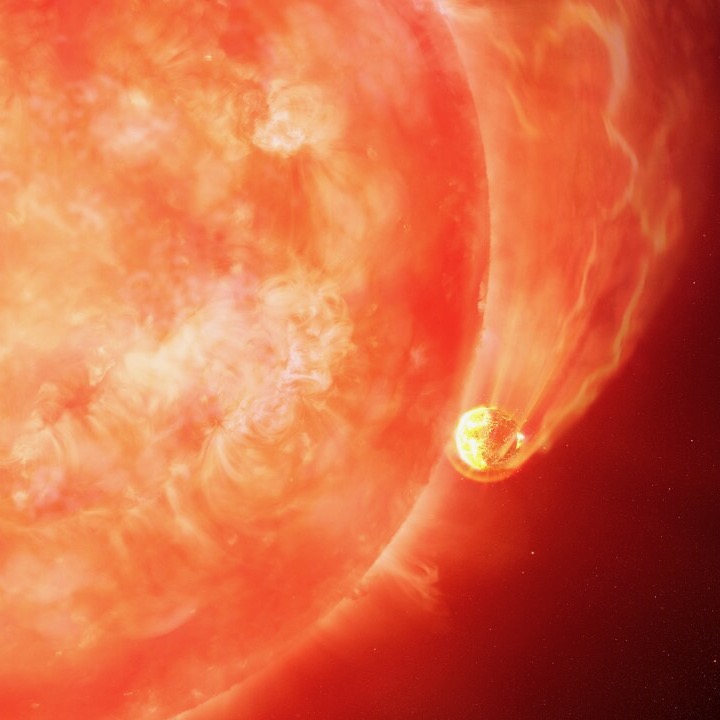Astronomers say that – for the 1st time – they’ve seen a star destroy its planet. The video above illustrates this glimpse into Earth’s future. Video via NASA/ JPL-Caltech/ R. Hurt & K. Miller (Caltech/IPAC).
NASA/JPL shared this original post on May 3, 2023. Edits by EarthSky.
Astronomers witnessed a dying star swell up and absorb a Jupiter-sized planet. As the star neared the end of its life, it grew in size, shrinking the gap with its neighboring planet before consuming it entirely. In about 5 billion years, our sun will go through a similar end-of-life transition. The sun will grow to perhaps 100 times its current diameter and become a red giant. As it does, it will absorb Mercury, Venus and possibly Earth. A new study published May 3, 2023, in the peer-reviewed journal Nature documents the first observation of an aging star swallowing a planet.
Star destroys its planet
Astronomers have identified many red giant stars and suspected that in some cases they consume nearby planets, but the phenomenon had never been directly observed before. Kishalay De, an astronomer at the Massachusetts Institute of Technology in Cambridge and the study’s lead author, said:
This type of event has been predicted for decades, but until now we have never actually observed how this process plays out.
Researchers discovered the event – formally called ZTF SLRN-2020 – using multiple ground-based observatories and the Near-Earth Object Wide Field Infrared Survey Explorer (NEOWISE) spacecraft. The planet was likely about the size of Jupiter, with an orbit even closer to its star than Mercury’s is to our sun. The star is at the beginning of the final phase of its life, the red giant phase, which can last more than 100,000 years.
As the star expanded, its outer atmosphere eventually surrounded the planet. Drag from the atmosphere slowed the planet down, shrinking its orbit and eventually sending it below the star’s visible surface. (Picture it like a meteor burning up in Earth’s atmosphere.) The transfer of energy caused the star to temporarily increase in size and become a few hundred times brighter. Recent observations show the star has returned to the size and brightness it was before merging with the planet.

Caught in the act
The Caltech-led Zwicky Transient Facility (ZTF) spotted the flash of optical light after the planet’s demise. ZTF looks for cosmic events that change in brightness rapidly, sometimes in a matter of hours. De was using ZTF to search for novas. Novas are when a dead, collapsed star (known as a white dwarf) cannibalizes hot gas from another nearby star. Novas are always surrounded by flows of hot gas, but follow-up observations of the flash by other ground-based telescopes showed much cooler gas and dust surrounding the star, meaning it didn’t look like a nova or anything else De had ever seen.
So De turned to the NEOWISE observatory, which scans the entire sky in infrared light every six months. The observatory produces all-sky maps to document how objects change over time. This data allowed De to see the star brightened almost a year before ZTF spotted the flash. The brightening was dust forming around the star and emitting infrared light.
De and team said the dust indicates that the planet didn’t go down without a fight. The planet pulled hot gas away from the star’s surface as it spiraled inward. As the gas drifted out into space, it cooled and became dust, like water vapor becoming snow. Then, the collision of the star and planet flung even more gas into space, producing more dust. De said:
Very few things in the universe brighten in infrared light and then brighten in optical light at different times. So the fact that NEOWISE saw the star brighten a year before the optical eruption was critical to figuring out what this event was.
Earth’s future
Five billion years from now, our sun will become a red giant, swallowing up Mercury, Venus and possibly Earth. But for these smaller planets, the light show should be much more subdued, according to De. The sun’s inner planets are many times smaller than the Jupiter-size planet in the ZTF-captured event. De said:
If I were an observer looking at the solar system 5 billion years from now, I might see the sun brighten a little, but nothing as dramatic as this, even though it will be the exact same physics at work.
Most mid-size stars will eventually become red giants, and theorists think that a handful of them consume nearby planets each year in our galaxy. The new observations provide astronomers with a template for what those events should look like, opening up the possibility of finding more. Joe Masiero, deputy principal investigator for NEOWISE at IPAC at Caltech, said:
This discovery shows that it’s worthwhile to take observations of the entire sky and archive them, because we don’t yet know all of the interesting events we might be capturing. With the NEOWISE archive, we can look back in time. We can find hidden treasures or learn something about an object that no other observatory can tell us.
Bottom line: Astronomers announced on May 5, 2023, that – for the first time – they witnessed a star destroying a planet. It’s a glimpse into Earth’s future.
Source: An infrared transient from a star engulfing a planet
The post A 1st! Star destroys its planet, previewing Earth’s future first appeared on EarthSky.
0 Commentaires